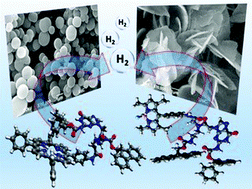A self-assembly study of PNA–porphyrin and PNA–BODIPY hybrids in mixed solvent systems†
Abstract
In this work a peptide nucleic acid (PNA) was covalently connected with two different chromophores, namely porphyrin and boron-dipyrromethene. To the best of our knowledge, this is the first example in the literature where a PNA unit is covalently linked to such chromophores. The self-assembly properties of the hybrids were examined through electron microscopy experiments by adopting the “good–bad” solvent self-assembly protocol. For both hybrids (PNA–TPP and PNA–BDP) we were able to observe distinctive supramolecular architectures. During these studies we investigated the influence of the solvent system, the concentration and the deposition method on the morphology of the formed nanostructures. In the case of PNA–TPP under all examined conditions well-formed nanospheres were obtained. Interestingly, in the PNA–BDP hybrid by simply altering the solvent mixture, self-assemblies of two different morphologies were formed (spherical and flake shaped). Absorption and emission studies suggested the formation of J-aggregates in all the obtained nanostructures. The nano-architectures assembled by PNA conjugates are capable of light-harvesting and producing hydrogen using Pt nanoparticles as a photocatalyst.



 Please wait while we load your content...
Please wait while we load your content...